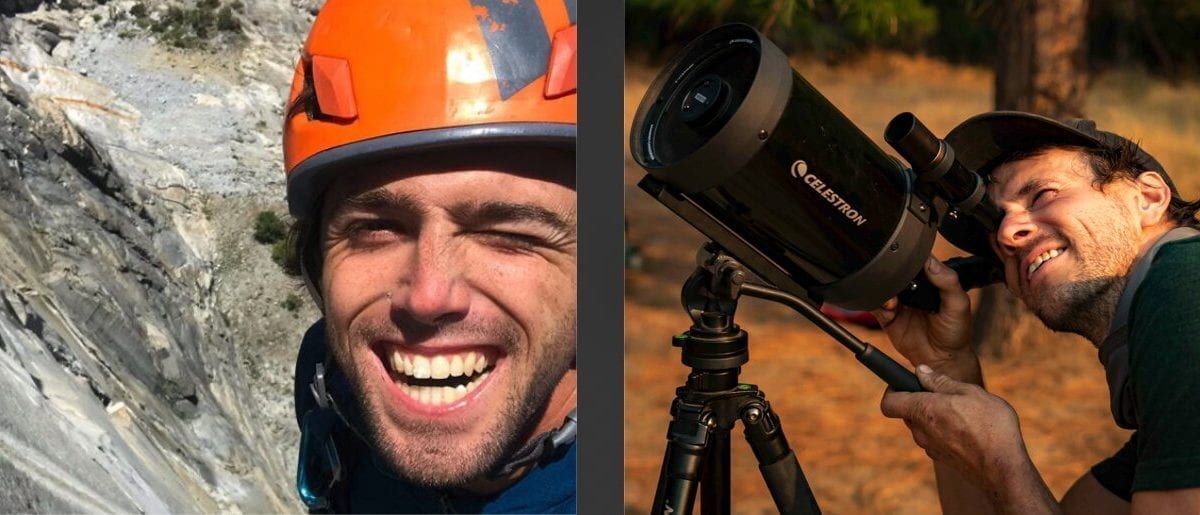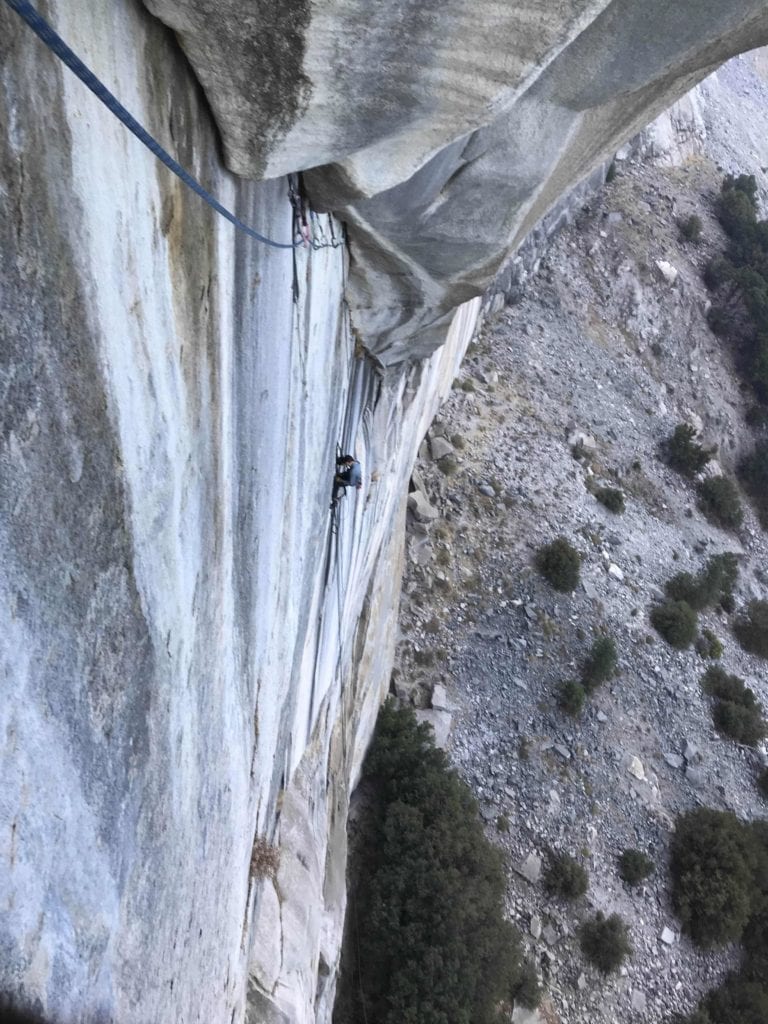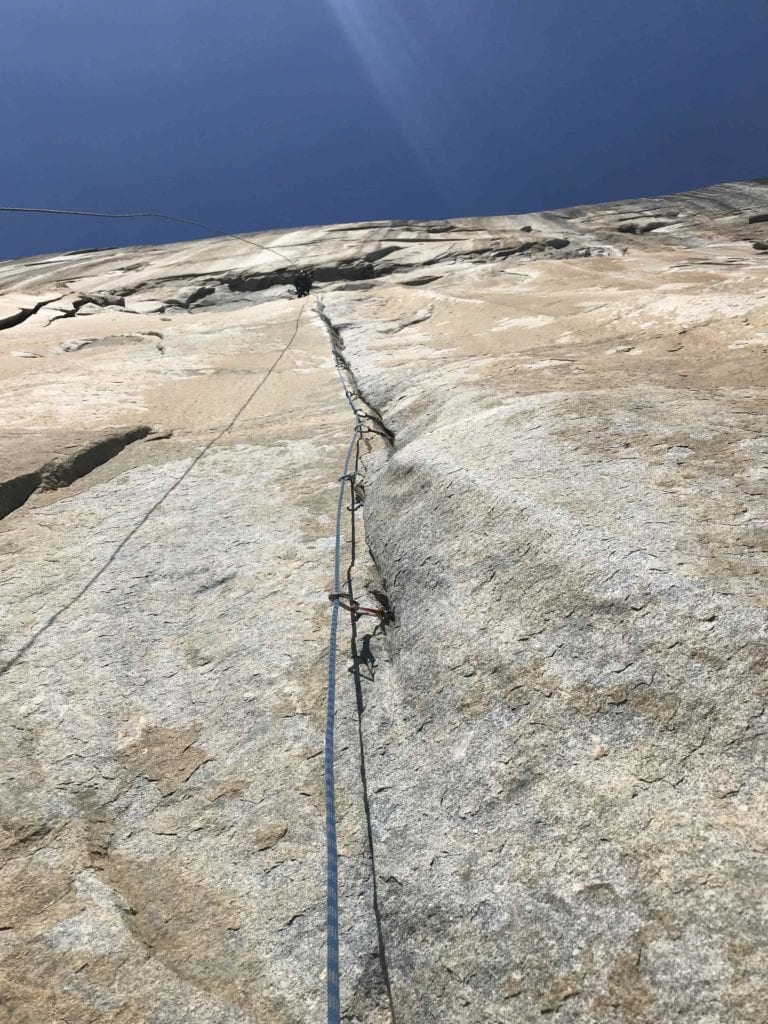Wild Chimneys and Endless Steeps: New Record Set on El Cap’s Aurora
On Oct. 14, Yosemite locals Lance Colley and Brandon Adams dashed up the 16 pitch 5.7 A4 Aurora on El Cap’s steep southeast face in 13:02, shedding 11 hours off the record set by Miles Smart and the late Brian McCray in 23:55 in 1998
 Photo by: Lance Colley and Max Buschini
Photo by: Lance Colley and Max Buschini
Midway across the southeast face of El Cap, where the orange stone is sliced by knife blade-width cracks and where flakes hang precariously from the wall Aurora stands proud. When it was established in 1981, the route was a contender for one of the hardest routes on the Big Stone. It’s only seen one previous in-a-day ascent, which was more than 20 years ago.
On October 14, Yosemite climbing ranger Brandon Adams and Yosemite campground ranger Lance Colley pulled out all their aid-climbing tricks to halve the record, bringing it down to 13 hours.

Their ascent marks Adam’s tenth El Cap speed record. Earlier this month he set the record for the Muir Wall. This was Colley’s first El Cap speed record. Their climb marks the first time the two have done a big wall in Yosemite together.
Aurora is one of a cluster of routes that carve their way up the massively steep orange headwall on El Cap’s southeast face. Surrounding routes include the demanding aid lines Scorched Earth, Native Son, Atlantic Ocean Wall, and Iron Hawk. Due to the technically difficult aid on Aurora — endless stretches of copperhead seams, hard hooking sections, and periods of flared cam placements — the route remains a test piece.
Colley has done 15 El Cap ascents by 10 different routes and Adams has done 49 ascents via 30 different routes. Colley led the first half of the route and Adams led the top half.
After three pitches of mostly clean aid climbing on Tangerine Trip, Colley cut left out onto Aurora, where he entered a deep, dark feature called the Bat Cave. Here “it’s pretty loose and kinda gross,” Colley says. This is where the route follows an ominous outward flaring roof feature rated A2+, 5.8, and described as “No Fun” in SuperTopo: Big Walls (3). Here Colley squeezed into a dark, wet crack where, he says, “it feels like your body is being crushed in the mountain.”
At one-point birds flew out of the cracks and hit the team.
In addition to the pitch-dark, claustrophobic terrain, Colley also encountered slime and rock with a thin veneer of calcite that was so slick it spit out cams. “I had a 3 Camalot in and it looked bomber, then it skated like 3 inches when I got on it,” he says.
Once through the Bat Cave, Colley entered the radically steep, thin aid climbing and expanding flakes that Aurora is known for.

Adams took over at the top of pitch 6, which leads to The American Zone. Here he made a mantle off a hook, followed by clipping thin heads on the golden rock. Next, he overcame wide cracks followed by hard hooking, expanding rock and more stretches of copperheads. “It feels overwhelming at first,” he says of how it felt knowing he had to take the team from midway up the wall to the summit.
Pitch after pitch he repeated the cycle — clip a fixed head, pound in a beak, put in a shaky cam.
“Then, after 45 minutes of going for it, you start smiling and enjoy doing it,” Adams says. Gone are the cramps in his shoulders and the anxiety of relying on fixed copperheads that could blow out of the rock unexpectedly. Here his focus zeroed in on his one goal: Get to the top as fast as possible.
“If it’s over air and you’re going fast, I’ll grab a fixed head and give it a tiny test. I want it to hold body weight,” he says of the aluminum and copper blobs (copperheads) as thick as headphone wire mashed into the rock.
Adams describes the cruxes as “sustained hooking and heading and some beaking.” As for speed climbing pitch after pitch of hard aid, “It’s a battle doing such a steep route and putting it all together.”
Two and a half pitches from the top Aurora links back into Tangerine Trip. Here, though easier, the terrain remains heads up – sporty hooks are followed by shallow cams out of a roof and finally lower angle terrain where Adams hooked features on the face. A final wandering pitch of 5.6 took them to the top.
“By the top, I felt pretty worked, which is normal from jugging as fast as you can,” Colley adds.
History of Aurora
In 1981, and within the same month as establishing nearby Zenyatta Mendatta — then rated A5 — Peter Mayfield partnered up with Greg Child and started up Aurora. “We briefly checked out the line through some binoculars and then went for it,” Mayfield says in the guidebook. The route, then rated A5, was one of the hardest big walls on El Cap.
“Greg was doing some pretty athletic stuff up there. He would call for tension, then lean way to the side, his body horizontal, toeing on a scallop of rock to just barely reach the next placement.”
But Child put his leads a different way, almost Zen-like: “Every move and placement flowed as naturally as the stone that accepted it.”
When the team reached their bivy in the Bat Cave hundreds of bats flew out at them. “Their flight path was six inches above my face and the ledge gently vibrated as many of them bumped into the straps,” Mayfield continues.
They named their route after the bright sunsets they encountered during their climb; the sky filled with swirls of color.

The Speed Team: Lance Colley and Brandon Adams
In April 2018 Colley moved to Yosemite, where he works for the Park Service as a campground ranger. He also helps with bear patrol. “When I’m in the campgrounds, I’m mostly looking for food storage problems. I also help the bear team when they need me. There are a lot more bears this year and fewer people than usual, so I’ve been chasing bears around a lot.”
Adams is one of five Yosemite Climbing Rangers and this is his sixth season. His duties include trail work and “spending a lot of time in El Cap meadow answering questions and keeping the wilderness ethic alive. I’m keeping people from storing food at the base of El Cap and have been cleaning up the top of El Cap. It’s been several years of work and thousands of pounds of trash coming out from up there. It’s starting to feel like wilderness again up there.”
As for his dedication to big wall speed climbing and the challenges associated with it, Adams says, “the main struggle is finding partners for those harder aid pushes.” That partly explains why the previous Aurora record stood for 22 years. Success on big wall speed climbing comes down to having the right team, the right tools and the right experience.
Previous to roping up with Colley on Aurora, Adams’s primary speed-climbing partner was Roger Putnam. Together the two raced up some of El Cap’s longest routes, nabbing the record on the Shield (8:55), the Muir Wall (12:07), Mescalito (13:46) and others. In total, they’ve set five records on El Cap.
“I love climbing with Roger and I hope to climb with him forever,” Adams says. But since Putnam has moved out of the park to work as a professor in Moorpark, Calif., Adams has connected with various other partners. With Colley, he sees a future partnership where he believes they can set even more records.
“We had a great time. He’s up and coming, and he shows the most promise,” Adams says. “He’s picking it up; he’s going to get good, fast.”


